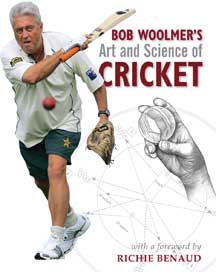The weekend read – Bob Woolmer's Art and Science of Cricket
March 13th, 2009 by TWC in Miscellaneous and tagged Bob Woolmer, weekend read
Every Friday we’ll be picking a classic cricket book that has been reviewed in TWC to help you pass the weekend. Make your recommendations in the comments below.
What is it?
Bob Woolmer’s Art and Science of Cricket by Bob Woolmer and Tim Noakes (New Holland Publishers, hb, 655pp, £30)
What’s it all about?
Bob Woolmer brings the game’s teaching manuals comprehensively up to date
What did we give it?
4/5
What did we say?
An admission: I have not read every word of Bob Woolmer’s Art and Science of Cricket. But I feel little guilt about that. The book is over 650 pages long and not designed to be read from start to finish. It is a reference book that will sit invaluably in a club’s pavilion or on the sturdiest shelves of any cricketing enthusiast.
Even if you have decided that the purchase of one more bat or pair of boots is too much of an extravagance in the autumn of your career, there is much to cherish here. As in all the best coaching manuals it is the specific examples, demonstrating a more general truth, that can captivate ex-players as well as current ones.
The book also serves as a poignant memorial of Woolmer’s life. It will soon become a compulsory text for those hoping to make their way in the game, in the same league as some of the masterpieces of the past. Woolmer, who has collaborated here with the sports scientist Tim Noakes, is quick to acknowledge the quality of some of those gems, like Don Bradman’s Art of Cricket and Mike Brearley’s Art of Captaincy, though he may have regarded both these offerings as rather brief. Where Brearley quotes the Greek historian Xenophon at the end of his book, Woolmer is more likely to quote Dermot Reeve.
On Bradman’s Art of Cricket Woolmer writes: “Yet nowhere in his book does Bradman suggest that his batting method was unique, much less a superior solution to the challenges faced by batsmen; nor does he clearly differentiate his method from that taught in the MCC coaching manual.”
There is no doubt that we have moved on from the MCC coaching manual. For proof we can turn to the section on reverse sweeping, a trademark shot of the Warwickshire side that Woolmer coached in the 1990s. I enjoyed his recollection of a little incident at Edgbaston during that time.
It was agreed at a team meeting that everyone should practise the shot in the nets before attempting it in the middle. But no one informed Warwickshire’s 2nd XI coach, Neal Abberley, something of a traditionalist in these matters. Woolmer remembers seeing a tearful Roger Twose stomping away across the tarmac. Twose had just been expelled from the nets by Abberley for playing the reverse sweep.
It will not surprise those who know of Woolmer’s famous openness to the unorthodox that there is a sequence of photos, with Jacques Kallis as the model batsman, demonstrating the defensive reverse sweep. Yes, the defensive reverse sweep. I am still not sure whether Abberley would approve.
Nor does the MCC manual have sections on the pathology of lumbar stress-fractures in fast bowlers or on tobacco and alcohol. We are informed in this treatise that “the shift in attitude towards alcohol by the world’s toughest competitors hopefully presages a move away from the long and unhappy marriage between cricket and the pub so prevalent in the twentieth century”. Ah, well, welcome to the 21st century.
Vic Marks, November 2008
What did they say?
Everything from the mysteries of swing to sledging and spinal injuries is analysed in this hefty tome (656 pages), with a price to match, but for players and fans alike it is value for money. Just try to keep it out of the hands of the opposition.
Simon Redfern, The Independent
Why not tell us what your favourite cricket book is, or which book you’d like to see in ‘The weekend read’ in the comments below …
Posted in Miscellaneous | No Comments »

